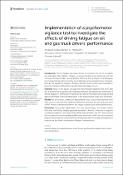Options
Implementation of a Psychomotor Vigilance Test to Investigate the Effects of Driving Fatigue on Oil and Gas Truck Drivers’ Performance
Journal
Frontiers in Public Health
Date Issued
2023
Author(s)
Al-Baraa Abdulrahman Al-Mekhlafi
Ahmad Shahrul Nizam Isha
Maged S. Al-Quraishi
Noreen Kanwal
DOI
10.3389/fpubh.2023.1160317
Abstract
Introduction: Driving fatigue has been shown to increase the risk of accidents
and potentially fatal crashes. Fatigue is a serious risk that some drivers do not take
seriously. Previous studies investigated the effects of driving fatigue in the Malaysian
oil and gas transportation industry by employing survey questionnaires. However,
they did not explain the behavior of fatigue. Besides, these results required validation
by a more reliable method that can describe how fatigue occurs.
Methods: Thus, in this study, we used the Psychomotor Vigilance Test (PVT-192)
and a short survey to address driving fatigue behavior and identify the influences of
driving fatigue on driving performance in real life (on the road) with actual oil and
gas tanker drivers. The total participants in the experimental study were 58 drivers.
Results: For the analysis, a Wilcoxon Signed Ranks Test, Z value and Spearman’s rho
were used to measure the significant difference between the pre and post-tests
of PVT and the correlation between the fatigue variables and driving performance.
Discussion: During the experiment’s first and second days, this study’s results
indicated that driving fatigue gradually escalated. Likewise, there was a negative
correlation based on the test of the relationship between the PVT data and the
driving performance survey data. Additionally, the drivers suffer from accumulative
fatigue, which requires more effort from the transportation company management
to promote the drivers awareness of fatigue consequences.
and potentially fatal crashes. Fatigue is a serious risk that some drivers do not take
seriously. Previous studies investigated the effects of driving fatigue in the Malaysian
oil and gas transportation industry by employing survey questionnaires. However,
they did not explain the behavior of fatigue. Besides, these results required validation
by a more reliable method that can describe how fatigue occurs.
Methods: Thus, in this study, we used the Psychomotor Vigilance Test (PVT-192)
and a short survey to address driving fatigue behavior and identify the influences of
driving fatigue on driving performance in real life (on the road) with actual oil and
gas tanker drivers. The total participants in the experimental study were 58 drivers.
Results: For the analysis, a Wilcoxon Signed Ranks Test, Z value and Spearman’s rho
were used to measure the significant difference between the pre and post-tests
of PVT and the correlation between the fatigue variables and driving performance.
Discussion: During the experiment’s first and second days, this study’s results
indicated that driving fatigue gradually escalated. Likewise, there was a negative
correlation based on the test of the relationship between the PVT data and the
driving performance survey data. Additionally, the drivers suffer from accumulative
fatigue, which requires more effort from the transportation company management
to promote the drivers awareness of fatigue consequences.
Subjects
File(s)
Loading...
Name
Implementation of a psychomotor vigilance test to investigate the effects of driving fatigue on oil and gas truck drivers’ performance.pdf
Size
1.42 MB
Format
Adobe PDF
Checksum
(MD5):096963d99514cbb66d26a1ac06413bc1